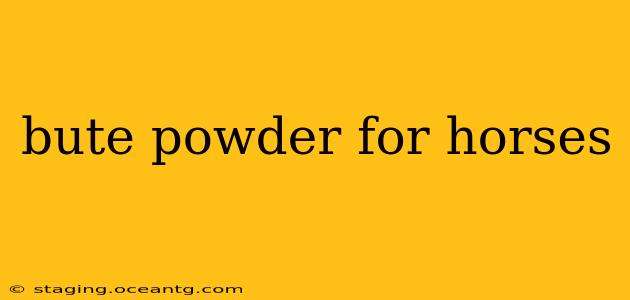Phenylbutazone, commonly known as bute, is a non-steroidal anti-inflammatory drug (NSAID) frequently used in equine medicine to manage pain and inflammation. While effective in relieving discomfort, it's crucial to understand its proper usage, potential side effects, and the importance of veterinary oversight. This comprehensive guide explores bute powder for horses, addressing common questions and concerns.
What is Bute Powder Used For in Horses?
Bute powder, a common form of phenylbutazone for horses, is primarily prescribed to alleviate pain and inflammation associated with various conditions. These include:
- Lameness: Bute effectively reduces pain and inflammation in joints affected by arthritis, osteoarthritis, and other lameness-causing conditions.
- Colic: While not a primary treatment, bute can help manage pain associated with mild colic episodes. Severe colic requires immediate veterinary attention.
- Post-surgical pain: Bute is often administered after surgery to control postoperative pain and inflammation.
- Soft tissue injuries: It can be used to treat pain and inflammation from sprains, strains, and other soft tissue injuries.
How Does Bute Powder Work in Horses?
Bute works by inhibiting the production of prostaglandins, chemical messengers responsible for inflammation and pain sensation. By reducing prostaglandin production, bute effectively decreases swelling, pain, and fever. It's important to note that bute does not address the underlying cause of the problem; it simply manages the symptoms.
What are the Side Effects of Bute Powder in Horses?
While generally effective, bute can cause side effects, some of which can be serious. These include:
- Gastrointestinal ulcers: This is a common and potentially severe side effect. Ulcers can lead to bleeding, colic, and other complications.
- Kidney damage: Prolonged or improper use of bute can strain the kidneys.
- Liver damage: Similar to kidney damage, excessive bute use can negatively impact liver function.
- Blood disorders: In some cases, bute can affect blood cell production.
- Allergic reactions: Although rare, allergic reactions to bute are possible.
How is Bute Powder Administered to Horses?
Bute powder is typically mixed with feed or water. The dosage is strictly determined by a veterinarian based on the horse's weight, condition, and the severity of the problem. Never administer bute without a veterinarian's prescription and guidance.
Is Bute Powder Safe for Horses?
Bute can be safe and effective when used correctly under veterinary supervision. However, the potential for serious side effects necessitates careful monitoring and responsible use. The risks associated with bute use must be weighed against the benefits of pain and inflammation relief.
Can I Buy Bute Powder Over the Counter?
No. Bute powder is a prescription medication and should only be obtained and administered under the direction of a licensed veterinarian. Improper use can be detrimental to the horse's health.
How Long Does it Take for Bute Powder to Work in Horses?
The onset of action varies, but generally, you should see a reduction in pain and inflammation within a few hours. However, the full therapeutic effect may take longer to achieve.
What are the Alternatives to Bute Powder for Horses?
Several alternative NSAIDs are available for horses, each with its own set of benefits and risks. A veterinarian can help determine the most appropriate medication based on the individual horse's needs and condition.
Conclusion: Responsible Bute Use in Equine Care
Bute powder can be a valuable tool in managing pain and inflammation in horses, but its use should always be guided by a veterinarian. Understanding the potential side effects, proper administration, and the importance of veterinary oversight is crucial for ensuring the safety and well-being of your equine companion. Always prioritize responsible medication use to avoid potential complications and ensure optimal equine health.
